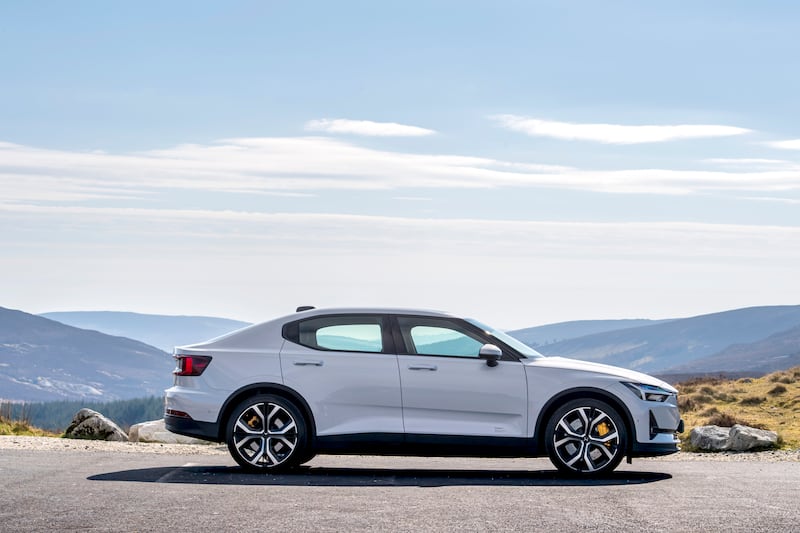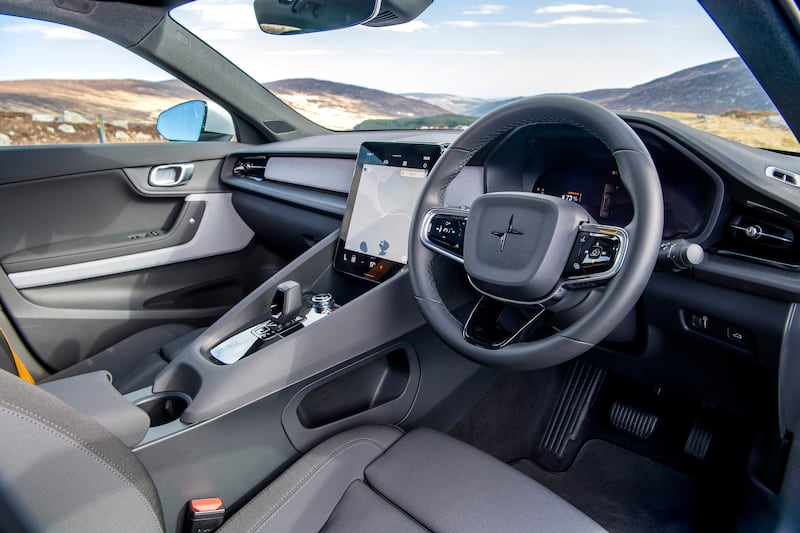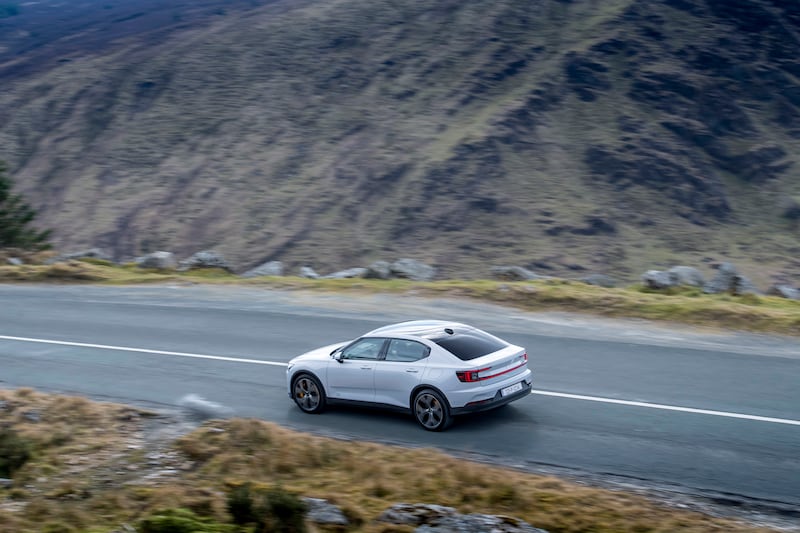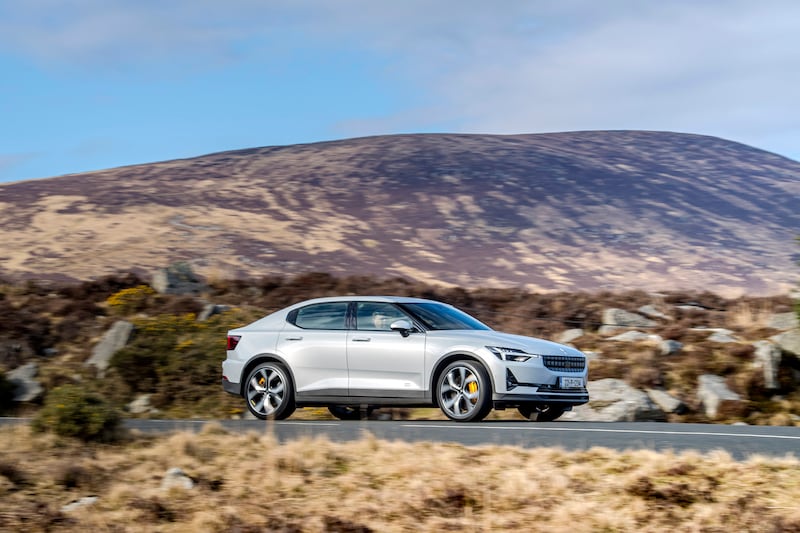It’s 11.30pm on a Saturday night at a filling station outside Athlone and the forecourt is full. Inside, a queue of Galway hurling fans, aged from eight to 80, snakes around the shop’s stands towards a McDonalds counter.
Let’s park the debate about dragging people from the four corners of Ireland up to Croke Park for an evening throw-in that leaves them on the road into the early hours with a car full of kids.
Consider if that trek to and from Croke Park, or the Aviva, was in an electric car.
My trip in the new all-electric Polestar 2 was from Mayo to Dublin and back in one day. Aside from 30km or so on a regular national road, the rest of it was spent on quality motorway or dual carriageway. So the roads infrastructure is there, but what about the charging one?
READ MORE
My trip involved two stops to charge along the way and two hours on a charger at my destination. All eminently do-able and relatively convenient.
The first stop was at a 50kW charger, as all the ultra-fast rapid chargers en route were occupied. It meant 45 minutes parked up in the corner of a filling station in Ballinasloe. On the way back that night, I was the only one using the Ionity charger and it was a Godsend, charging from just over 40 per cent to 77 per cent in just 23 minutes, the time it took to have a coffee.
But what if more of the Galway contingent had opted for electric? If even half the cars visiting the fuel pumps were diverted to the four Ionity chargers then we’d probably still be sitting in the parish of Fassagh drinking coffee.
Thankfully, there are now charging stations within a few kilometres of most major motorway junctions. Many country towns have at least a couple of 22kW points. But are there enough to support the rapid growth in electric vehicle sales?
When it comes to public charging points, we’ve come a long way, but we’ve a lot further to go. The Government’s infrastructure strategy claims the current network of public charge points will be sufficient to meet demand over the next few years. That seems ambitious when you are on the road or queueing for a charge point.
The electric car evangelists and early adopters accepted the need to plan every trip like a military campaign as the price to be paid for being at the vanguard of the revolution. It’s the same with all tech advances. But as the technology seeps through society to the mainstream, there’s a lower tolerance threshold.
The beauty of the EV revolution is that it’s wiping the slate clean of outdated brand prejudices
Between the ESB’s ultra-fast charging stations and the handful of Ionity stations there is progress being made. But unless you have access to these ultra-fast chargers on your route, dishing out 150kW or more, then you are going to be adding significant time to any cross-country trip. If you’re on a leisurely tour of Ireland, then no sweat. If you’re chauffeuring a car full of grumpy children in the wee hours of the morning, then adding 45 minutes or more parked up at a service station is no fun.
If a recession is around the corner, then we need to be wary of its likely impact on infrastructure investment. The last recession wrote off the grand plans to turn Ireland into a testbed for electric cars. Government claims that the current infrastructure is adequate for the next few years is a cause for concern, particularly if you are considering an investment of €55,000-plus in a new electric car.
For that money, you do admittedly get a very impressive premium car in the form of the Polestar 2.
The newest brand on the Irish market, Polestar, is a premium all-electric offshoot from Volvo’s Chinese parent Geely.
The beauty of the EV revolution is that it’s wiping the slate clean of outdated brand prejudices. The public is open to new brands and is already incredibly knowledgeable about the likes of Polestar.

I wasn’t expecting the level of interest in the Polestar. At every turn people were coming up to the car with a level of knowledge that caught me by surprise. “That’s the dual-motor version, is it? 408bhp?” was the question from one impressed teenager preparing for his driving test. He was joined by an older man who wondered if it had the Performance pack with the Brembo brakes. This encounter was not unique. Wherever we stopped in the Polestar 2, people came up to take a look. I’ve tested German sports cars at three times this price that attracted less attention.
The good news is that Polestar has enough going for it to stand out from the crowd
Clearly, Polestar has caught the public’s attention. Thankfully for the Swedes, they should be able to keep it with this car. While an SUV model is due to be added to the Polestar fleet later this year, for now the Polestar 2 is forging ahead for the brand. A mix of crossover and fastback saloon, it’s nicely styled, spacious and boasts a comfortable and refined cabin.
Admittedly the Volvo link is very evident in the Polestar 2. There are the big screen controls, the clean, uncluttered cabin and even the comfortable seats. The Polestar could easily sit in any Volvo showroom. Yet it delivers a rather sportier edge than its Swedish sibling.

That’s only fitting, for the Polestar name traces its roots back to a Swedish racing team from 1996 and was the moniker for tuned-up road-going Volvos in the last decade before the decision to turn it into an all-electric standalone brand.
In an increasingly busy €50,000-plus segment of the premium new car market, the good news is that Polestar has enough going for it to stand out from the crowd. Taking on the established brands, it has the sort of differentiation from the crowd that Saab owners used to love years ago.
It also seems better put together and more comfortable inside than its Tesla rival. Opting for Google-based screen software, it’s also easier to use than most of its rivals.
With the Polestar 2 you get the option of a single motor with 67kWh battery and a claimed range of 474km starting from €54,400. Increase the spend to €58,245 and you get a 75kWh battery with a maximum claimed range of 540km.
Neither of these is particularly sporty, but opt for the dual-motor four-wheel-drive set-up of our test car and you get 408hp and a 0-100km/h time of 4.7 seconds, from a car that’s properly satisfying to drive.
Clearly targeting the Tesla Model 3 and the BMW i4, the Polestar 2, in single motor long-range stance, can claim an edge on both
It’s fast without the fury and at its sharpest weaving through a series of bends. The test car also came with Polestar’s Performance pack. For an extra €6,420 the manually-adjustable suspension developed by Swedish specialists Öhlins gives the Polestar 2 incredible cornering poise, while the Brembo brakes anchor the car better than any of its rivals.
And there’s only a marginal trade-off in range, with a claimed range of 460km or so, which in real-world conditions is likely to be closer to 400km or so.
At low speeds, the Polestar 2′s Ohlins set-up is perfectly calm, on the back roads it’s like a guided missile. That said, we did find the ride quality can turn very firm either side of 80km/h, like a giddy horse before the off.

It brought back memories of early versions of the R performance cars introduced by Volvo years ago when it wanted to create a rival for BMW’s M Division. While they had the performance, the suspension set-up was never quite right. You could switch settings between Comfort, which was a wibbly wobbly wonder, or Sport, which had all the suppleness of a Formula One car.
For the most part, Irish buyers are unlikely to opt for the dual motor set up, nor the extra spend on Performance pack. Instead, they’ll opt for the long-range single motor.
What they’ll get is a mix of Volvo safety, credible battery efficiency, decent family practicality and better build quality than many rivals, in a car that delivers the sort of handling and satisfying drive you’d expect from engineers with proper sports car pedigree.
All that comes at a very competitive price range as well. Clearly targeting the Tesla Model 3 and the BMW i4, the Polestar 2, in single motor long-range stance, can claim an edge on both when you balance out the price, performance, practicality and promised range.
Against the BMW, the dual-motor version closely matches its dynamic appeal, though the Bavarian has an edge. Against the Tesla, this Polestar is better priced and seems better built. It’s also much better looking.
With an online buying model — but aftersales care and servicing from Volvo dealers — and a promise that stock is available for registration, the stars are aligning nicely for this latest EV arrival.
And if it does mean you’ll be sitting in a queue for chargers at Fassagh service station due to the Government’s lack of commitment to a faster-charging infrastructure roll-out, at least the Polestar 2 is a comfortable place to pass the time.

Polestar 2: The lowdown
Power: A battery pack with 75kWh of useable capacity powers two 150kW motors combining to put out 408hp with 660Nm of torque
Range: 463km (when fitted with optional Performance and Plus packs)
0-100km/h: 4.7 seconds
Price: €74,295 as tested (Dual motor version starts at €61,990)













